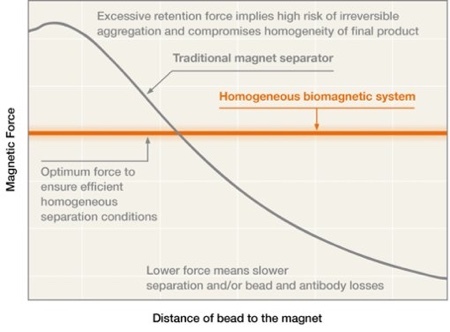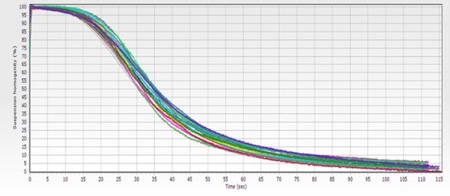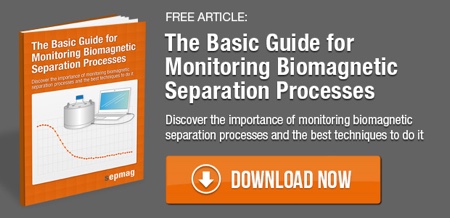Biomagnetic separation techniques have revolutionised the biology and medical fields. The main advantage of this technology is its versatility in being able to separate all kinds of targets, from small molecules to whole cells. It also allows a faster and less laborious protocol to be developed without compromising the purification.
All biomagnetic separation techniques are based on the same principle: magnetic particles, which come in different compositions, sizes and shapes that determine their chemical and physical properties. The magnetic beads for bioseparation are usually composites, including nanosized particles of magnetite (Fe3O4) or maghemite (gamma Fe2O3) with superparamagnetic properties, that form one or more magnetic cores. The ferromagnetic particles have permanent magnetism once exposed to magnetic fields and are suitable for the purification of molecules in high viscosity solutions. The superparamagnetic particles are magnetised only when an external magnetic field is applied but return to a non-magnetic state once the field is removed from their vicinity, allowing easy resuspension, large surface area, slow sedimentation and uniform distribution.
The nanosized particles are usually coated with a matrix of polymers, silica or hydroxylapatite, and coated with a ligand that is able to bind to a certain target molecule. The separation of the ligand in solution is achieved by applying magnetic forces that physically move the magnetic carriers to a retention area. It is then easy to wash, and the particle-target complexes, and then re-suspends on a clean buffer where it is possible to elute the purified target and separate the magnetic carrier once again.
This property of magnetic separation is key since it avoids multiple centrifugation or filtration steps that usually reduce the yield. By avoiding the steps required in traditional separation techniques, the protocols can be simplified and achieved more quickly. This is important since it allows the creation of automated systems, with less hands-on time and increased reproducibility of the results.
The ability to process large volume samples increases the cost-effectiveness of separation protocols, especially in industrial biotechnology settings
Biomagnetic separation can be applied for purification of low concentrated targets and large volume solutions, which was not possible with previous separation techniques. The ability to process large volume samples increases the cost-effectiveness of separation protocols, especially in industrial biotechnology settings. On the other hand, the ability effectively to recover targets that are at low concentrations in solution or rare populations of cells is essential for molecular biological diagnostic procedures.
When implementing a magnetic separation process there are several factors to take into account for the protocol to go as expected. Even before purchasing reagents, the exact experimental conditions need to be clearly defined. Because these technologies have been around for some time and are very versatile, there are many variations in the reagents and protocols that should be adjusted to the experimental goal. If the wrong beads are chosen specificity problems can arise because the beads are not the right diameter for the target. Cross‐reactions due to the incorrect coating can occur, along with other experimental issues.
The experimental conditions, such as the sample type and the magnetic field, are equally important and can have a major effect on the outcome. The first step is to focus on finding the right kit for the purpose in hand. The kits are optimal because the beads’ characteristics are already adjusted to the samples and to the magnetic field, leaving only selection of the right biomarker, optimisation of the coupling between ligand and target, and selection of the magnetic properties of the bead to consider.
The ideal magnetic bead should have some essential properties, namely: high recovery, no aggregation and high reproducibility of results
The ideal magnetic bead should have some essential properties, namely: high recovery, no aggregation and high reproducibility of results. These parameters will vary with the application and sometimes a compromise is necessary. For example, with a large volume sample beads should be chosen that allow fast purification, low bead and coupled biomarker losses and easy resuspension after the separation.
If the beads are supermagnetic, several additional steps will be required to obtain a homogeneous solution. If the criteria for perfect beads are not met the separation process will be defective. Purchasing new beads can be time-consuming and expensive, especially if they were tailormade. However, the effect of the separation rack cannot be ignored and when a separation protocol goes wrong, it does not always signify poor magnetic bead performance. The biomagnetic separation system should allow the beads to retain the target molecules quickly, moving at the same speed to avoid irreversible aggregation problems. It is cheaper and easier to check if the problem stems from the separation rack.
Kit to kit reproducibility is also important when using a biomagnetic separation technique. The most common source of variability is irreversible aggregation of the beads during the separation process caused by non-homogeneous magnetic force. Sepmag has advanced biomagnetic separation systems that prevent the technical difficulties associated with an inappropriate magnetic field – namely increased bead aggregation, high beads losses and a long separation time. This system is more effective due to the maintenance of a specific magnetic field pattern that exposes all the beads to the same magnetic force, hence reducing the risk of aggregation.
The problem with standard magnetic separators is that they generate magnetic field profiles that always lead to magnetic forces that vary with distance, as shown in Figure 1. This generates a very low force over the beads far from the retention area (leading to losses and/or very long separation times), but at the same time generates an excessive retention force leading to problems with the irreversible aggregation of magnetic particles, which makes the results less consistent.

Figure 1: Magnetic force profile for the different magnetic separation devices
To disaggregate beads that have aggregated during the separation process a sonication method can be used, but this can be laborious and expensive with large volumes and makes the protocol longer. Beads that are or have aggregated perform very differently from beads that are not and can give functionally inconsistent results, even if an homogeneous solution has been achieved through sonication.
On the other hand, using advanced biomagnetic separation processes, Sepmag has obtained a homogeneous strength that guarantees the consistency, speed and scalability. The magnetic field pattern in Sepmag bioseparation systems apply forces that are constant relative to the distance from the magnet, which means that the forces on the farthest beads are higher than in classic separators, reducing the purification time while retaining the magnetic beads with the appropriate force, thus avoiding irreversible aggregation.
To ensure reproducibility and process efficiency, quality control also must be considered
To ensure reproducibility and process efficiency, quality control also must be considered. The new systems from Sepmag allow the monitoring of each separation process and to verify set by set variability. To set up a protocol each step of the process should be validated first and all the technical variables that can be important to improve the separation should be considered. Batch-related variability is also an important parameter to monitor since it can alter the experimental results dramatically. This quality control is especially relevant in production processes where the best conditions for the beads, the sample preparation and the magnetic field need to be defined.
One of the most important factors for successful magnetic separation is the magnetic field pattern that needs to exert a constant force over the entire batch volume. This will ensure that all the magnetic beads experience the same conditions during the process, avoiding variability in the batch (i.e. some beads aggregated because of excessive force, while others lost because they did not reach the retention area).
If the system used provides a homogeneous magnetic force, problems with the beads or the buffer solutions can be more readily pinpointed, as it is known that the magnetic separation would be the same for all the working volume. As the mixture of beads in the buffer is usually opaque when the beads are in syspension but transparent when the solids have separated, this gradual change can be used to monitor the process optically. As the force is homogenous over the whole working volume, any changes to the shape of the graph which plots time change versus opacity would imply batch to batch variability caused by the reagents, buffer or concentration, and should raise an alert to assure the consistency of the product/process.
The best way to set up the protocol and check for separation quality and reproducibility is to define a standard curve to work as a reference. To define this curve data needs to be collected from the first batches that have been correctly validated and then used to define the time and suspension homogeneity, as shown in Figure 2.

Figure 2: Evolution of the biomagnetic separation process for different batches of the same suspension
Biomagnetic separation techniques are a powerful tool for a variety of research, industrial and medical applications. The coupling of magnetic properties with specific ligands in magnetic beads allows the separation and purification of cells, proteins, nucleic acids and other molecules, in a highly efficient and specific manner. This technique has driven a technological revolution in biological research. Using advanced biomagnetic separation processes already proven in producing diagnostic kits on a broad scale, opens the doors to the use of this technique in other biotechnology fields.
The latest equipment, such as that provided by Sepmag, offers advantages in the development of magnetic separation protocols for a wide range of settings. One example is the high‐throughput devices, which allow magnetic separation to be applied in situations where before it was impossible, such as in high volume samples that are typical of industrial settings. The relevance of magnetic particles in research is now unquestionable since it allows a technological leap, by optimising essential laboratory techniques. In the ever changing field of biological research, biomagnetic separation technology is a driver for technical innovation.





